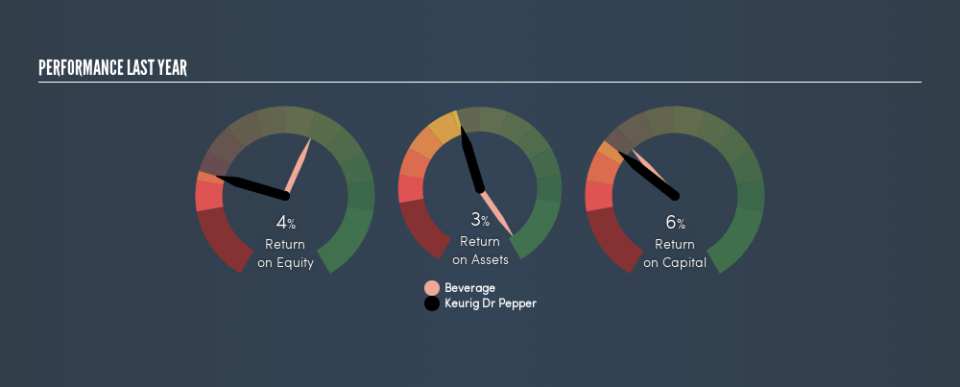Here’s why Keurig Dr Pepper Inc.’s (NYSE:KDP) Returns On Capital Matters So Much

Today we'll evaluate Keurig Dr Pepper Inc. (NYSE:KDP) to determine whether it could have potential as an investment idea. In particular, we'll consider its Return On Capital Employed (ROCE), as that can give us insight into how profitably the company is able to employ capital in its business.
Firstly, we'll go over how we calculate ROCE. Then we'll compare its ROCE to similar companies. Then we'll determine how its current liabilities are affecting its ROCE.
What is Return On Capital Employed (ROCE)?
ROCE is a measure of a company's yearly pre-tax profit (its return), relative to the capital employed in the business. Generally speaking a higher ROCE is better. In brief, it is a useful tool, but it is not without drawbacks. Renowned investment researcher Michael Mauboussin has suggested that a high ROCE can indicate that 'one dollar invested in the company generates value of more than one dollar'.
So, How Do We Calculate ROCE?
The formula for calculating the return on capital employed is:
Return on Capital Employed = Earnings Before Interest and Tax (EBIT) ÷ (Total Assets - Current Liabilities)
Or for Keurig Dr Pepper:
0.058 = US$2.5b ÷ (US$50b - US$6.7b) (Based on the trailing twelve months to June 2019.)
Therefore, Keurig Dr Pepper has an ROCE of 5.8%.
See our latest analysis for Keurig Dr Pepper
Is Keurig Dr Pepper's ROCE Good?
ROCE can be useful when making comparisons, such as between similar companies. Using our data, Keurig Dr Pepper's ROCE appears to be significantly below the 10% average in the Beverage industry. This performance could be negative if sustained, as it suggests the business may underperform its industry. Setting aside the industry comparison for now, Keurig Dr Pepper's ROCE is mediocre in absolute terms, considering the risk of investing in stocks versus the safety of a bank account. Investors may wish to consider higher-performing investments.
The image below shows how Keurig Dr Pepper's ROCE compares to its industry, and you can click it to see more detail on its past growth.
When considering ROCE, bear in mind that it reflects the past and does not necessarily predict the future. Companies in cyclical industries can be difficult to understand using ROCE, as returns typically look high during boom times, and low during busts. ROCE is only a point-in-time measure. What happens in the future is pretty important for investors, so we have prepared a free report on analyst forecasts for Keurig Dr Pepper.
Do Keurig Dr Pepper's Current Liabilities Skew Its ROCE?
Current liabilities include invoices, such as supplier payments, short-term debt, or a tax bill, that need to be paid within 12 months. Due to the way the ROCE equation works, having large bills due in the near term can make it look as though a company has less capital employed, and thus a higher ROCE than usual. To counteract this, we check if a company has high current liabilities, relative to its total assets.
Keurig Dr Pepper has total assets of US$50b and current liabilities of US$6.7b. Therefore its current liabilities are equivalent to approximately 14% of its total assets. This is a modest level of current liabilities, which would only have a small effect on ROCE.
What We Can Learn From Keurig Dr Pepper's ROCE
With that in mind, we're not overly impressed with Keurig Dr Pepper's ROCE, so it may not be the most appealing prospect. Of course, you might also be able to find a better stock than Keurig Dr Pepper. So you may wish to see this free collection of other companies that have grown earnings strongly.
If you like to buy stocks alongside management, then you might just love this free list of companies. (Hint: insiders have been buying them).
We aim to bring you long-term focused research analysis driven by fundamental data. Note that our analysis may not factor in the latest price-sensitive company announcements or qualitative material.
If you spot an error that warrants correction, please contact the editor at editorial-team@simplywallst.com. This article by Simply Wall St is general in nature. It does not constitute a recommendation to buy or sell any stock, and does not take account of your objectives, or your financial situation. Simply Wall St has no position in the stocks mentioned. Thank you for reading.

